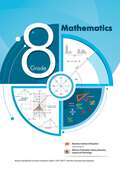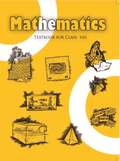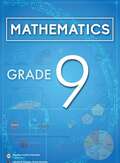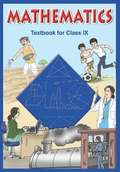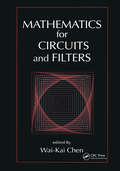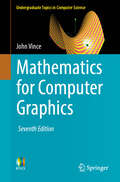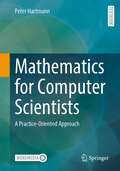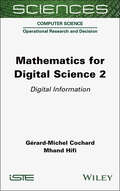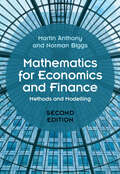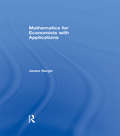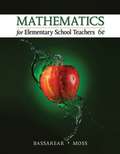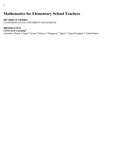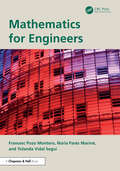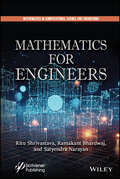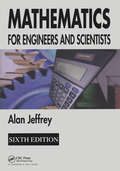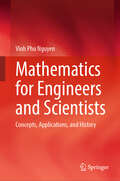- Table View
- List View
Mathematics class 7 - NCERT - 23
by National Council of Educational Research and TrainingThe NCERT Class 7 Mathematics textbook provides a comprehensive and structured approach to mathematical concepts for students. It covers a wide range of topics, including integers, fractions, decimals, geometry, algebra, and data handling. The book aims to develop a strong foundation in mathematical principles by introducing students to real-life applications and problem-solving techniques. Through engaging and interactive exercises, the textbook encourages active participation, fostering a deeper understanding of mathematical concepts. It emphasizes conceptual clarity, logical reasoning, and practical application, preparing students for more advanced mathematical studies. Additionally, the textbook incorporates activities that promote critical thinking, making the learning process enjoyable and meaningful for Class 7 students. Overall, the NCERT Class 7 Mathematics textbook is designed to instill a love for mathematics while equipping students with essential skills for their academic journey.
Mathematics class 8 - MIE
by Mauritius Institute of EducationThe Grade 8 Mathematics textbook by the Mauritius Institute of Education, published in 2021, presents a comprehensive curriculum aligned with the National Curriculum Framework. It covers diverse mathematical topics, including number sequences, indices, rate and proportion, coordinates, algebra, and geometry. Each chapter begins with clear learning objectives and provides ample exercises, examples, and summaries to aid comprehension. Emphasizing real-life applications, the textbook illustrates concepts such as Fibonacci sequences in nature and architectural scales, fostering contextual learning. The educational content is meticulously crafted to enhance learners' cognitive skills through practical activities and contextualized problem-solving. This textbook serves as an invaluable resource for Grade 8 students, facilitating their mathematical understanding and application in various real-world scenarios.
Mathematics class 8 - NCERT - 23
by National Council of Educational Research and TrainingThe Mathematics textbook for Class VIII by NCERT provides a comprehensive and structured approach to fundamental mathematical concepts for students at the eighth-grade level. The textbook covers a wide range of topics, including number systems, algebraic expressions and equations, geometry, mensuration, data handling, and practical geometry. With a focus on building problem-solving skills, the book incorporates real-life examples and engaging exercises to enhance students' understanding of mathematical principles. Through a balanced mix of theory and application, it aims to develop a solid foundation in mathematics, promoting logical reasoning and analytical thinking. The textbook aligns with the NCERT curriculum, ensuring that students acquire a strong mathematical foundation that will serve as a basis for their academic journey.
Mathematics class 8 - Tamil Nadu Board
by State Council of Educational Research and TrainingThe Tamil Nadu 8th Standard Mathematics textbook, part of the Free Textbook Programme by the Government of Tamil Nadu and revised in 2019, 2020, 2022, and 2023, emphasizes understanding over rote learning. It covers Numbers, Measurements, Algebra, Life Mathematics, Geometry, Statistics, and Information Processing. The book includes interactive activities, ICT corners, and exercises to apply mathematical concepts in real life. Key features like ‘Do you know?’, ‘Try this/these’, and ‘Mathematics Alive’ aim to enhance curiosity and understanding. Designed to mathematize a child’s thought process, it demonstrates the ubiquity of mathematics in nature and everyday life, fostering deep comprehension and engagement.
Mathematics class 9 - Goa Board
by National Council of Educational Research and TrainingThe Class IX Mathematics textbook by NCERT (National Council of Educational Research and Training) is a comprehensive resource designed to provide students with a strong foundation in mathematical concepts. The book covers a wide array of topics, including real numbers, polynomials, coordinate geometry, linear equations in two variables, Euclid's geometry, lines and angles, triangles, quadrilaterals, areas of parallelograms and triangles, circles, constructions, surface areas and volumes, statistics, and probability. Each chapter is meticulously structured to foster a deep understanding of mathematical principles, offering clear explanations, solved examples, and exercises that progressively challenge students' skills. The textbook emphasizes problem-solving strategies, logical reasoning, and practical applications, ensuring that students not only grasp mathematical theories but also develop problem-solving skills crucial for real-life situations. Additionally, it aligns with the NCERT curriculum, providing a balanced approach to mathematical concepts that encourages students to explore, analyze, and appreciate the beauty and utility of mathematics in everyday life.
Mathematics class 9 - MIE
by Mauritius Institute of EducationPublished by the Mauritius Institute of Education in 2021, the Grade 9 mathematics textbook offers a comprehensive alignment with the National Curriculum Framework, prioritizing the enhancement of learners' cognitive abilities through contextualized materials. Covering a range of topics including indices, binomial expressions, quadratics, and algebraic manipulation, the textbook incorporates exercises and continuous assessments to reinforce learning. Rooted in Variation Theory, the pedagogical approach aims to facilitate students' discernment of key concepts within each topic, fostering procedural fluency. This collaborative effort between MIE academics and seasoned educators ensures the delivery of high-quality content that effectively meets educational objectives, providing students with a solid foundation in mathematics.
Mathematics class 9 - NCERT
by National Council of Educational Research and TrainingMathematics Textbook For Class IX has been designed in a way so as to enable students to tackle difficult mathematical problems with ease. Published by NCERT, this book comprehensively covers the curriculum for the CBSE board and provides convenient ways of solutions to various numerical problems. The textbook has copious diagrams and solved examples to facilitate easier understanding and better adaptability among students. Unnecessary jargon is kept at bay, making mathematics more interesting for the students. Every topic is supported with abundant solved examples and practice sums to constitute a complete learning experience.
Mathematics class 9 - NCERT- 23
by National Council of Educational Research and Training"Mathematics: Class 9" by NCERT is a comprehensive textbook designed to facilitate a deeper understanding of fundamental mathematical concepts for students at the ninth-grade level. The book covers a wide range of topics including number systems, algebraic expressions, geometry, statistics, and probability. Each chapter is structured to provide clear explanations, examples, and exercises to reinforce learning. It emphasizes problem-solving skills, critical thinking, and mathematical reasoning through practical applications and real-life scenarios. With its systematic approach and engaging presentation, the textbook aims to equip students with the necessary skills and knowledge to excel in mathematics and build a strong foundation for future learning in the subject.
Mathematics class 9 - Tamil Nadu Board
by Government Of TamilnaduMathematics Textbook For Class IX has been designed in a way so as to enable students to tackle difficult mathematical problems with ease. Published by SCERT, this book comprehensively covers the curriculum for the board and provides convenient ways of solutions to various numerical problems. The textbook has copious diagrams and solved examples to facilitate easier understanding and better adaptability among students. Unnecessary jargon is kept at bay, making mathematics more interesting for the students. Every topic is supported with abundant solved examples and practice sums to constitute a complete learning experience.
Mathematics for Circuits and Filters
by Wai-Kai ChenEvery engineering professional needs a practical, convenient mathematics resource, without extensive theory and proofs. Mathematics for Circuits and Filters stresses the fundamental theory behind professional applications, making an excellent, flexible resource that enables easy access to the information needed to deal with circuits and filters.The sections feature frequent examples and illustrations, reinforcing the basic theory. The examples also demonstrate applications of the concepts. References at the end of each section are drawn from not only traditional sources, but from relevant, nontraditional ones as well, including software, databases, standards, seminars, and conferences. This leads advanced researchers quickly to the data they may need for more specialized problems.An international panel of experts developed the chapters for practicing engineers, concentrating on the problems that they encounter the most and have the most difficulty with. Mathematics for Circuits and Filters aids in the engineer's understanding and recall of vital mathematical concepts and acts as the engineer's primary resource when looking for solutions to a wide range of problems.
Mathematics for Computer Graphics (Undergraduate Topics in Computer Science)
by John VinceJohn Vince explains a comprehensive range of mathematical techniques and problem-solving strategies associated with computer games, computer animation, special effects, virtual reality, CAD and other areas of computer graphics in this completely revised and expanded seventh edition. The first five chapters cover a general introduction, number sets, algebra, trigonometry and coordinate systems, which are employed in the following chapters on determinants, vectors, matrix algebra, complex numbers, geometric transforms, quaternion algebra, quaternions in space, interpolation, statistics, curves and patches, analytical geometry and barycentric coordinates. Following this, the reader is introduced to the relatively new subject of geometric algebra, followed by two chapters that introduce differential and integral calculus. Finally, there are chapters on Fourier analysis and Worked examples. Mathematics for Computer Graphics covers all of the key areas of the subject, including: • Number sets • Algebra • Trigonometry • Complex numbers • Coordinate systems • Determinants • Vectors • Quaternions • Matrix algebra • Geometric transforms • Interpolation • Curves and surfaces • Analytic geometry • Statistics • Barycentric coordinates • Geometric algebra • Differential calculus • Integral calculus • Fourier analysis This seventh edition contains approximately 200 worked examples and over 350 colour illustrations, which are central to the author’s descriptive writing style. Mathematics for Computer Graphics provides a sound understanding of the mathematics required for computer graphics software and setting the scene for further reading of more advanced books and technical research papers.
Mathematics for Computer Scientists: A Practice-Oriented Approach
by Peter HartmannThis textbook contains the mathematics needed to study computer science in application-oriented computer science courses. The content is based on the author's many years of teaching experience.The translation of the original German 7th edition Mathematik für Informatiker by Peter Hartmann was done with the help of artificial intelligence. A subsequent human revision was done primarily in terms of content.Textbook FeaturesYou will always find applications to computer science in this book.Not only will you learn mathematical methods, you will gain insights into the ways of mathematical thinking to form a foundation for understanding computer science.Proofs are given when they help you learn something, not for the sake of proving.Mathematics is initially a necessary evil for many students. The author explains in each lesson how students can apply what they have learned by giving many real world examples, and by constantly cross-referencing math and computer science. Students will see how math is not only useful, but can be interesting and sometimes fun.The ContentSets, logic, number theory, algebraic structures, cryptography, vector spaces, matrices, linear equations and mappings, eigenvalues, graph theory.Sequences and series, continuous functions, differential and integral calculus, differential equations, numerics.Probability theory and statistics.The Target AudiencesStudents in all computer science-related coursework, and independent learners.
Mathematics for Digital Science, Volume 1: Fundamentals (ISTE Consignment)
by Gerard-Michel Cochard Mhand HifiOver the past century, advancements in computer science have consistently resulted from extensive mathematical work. Even today, innovations in the digital domain continue to be grounded in a strong mathematical foundation. To succeed in this profession, both today's students and tomorrow’s computer engineers need a solid mathematical background. The goal of this book series is to offer a solid foundation of the knowledge essential to working in the digital sector. Across three volumes, it explores fundamental principles, digital information, data analysis, and optimization. Whether the reader is pursuing initial training or looking to deepen their expertise, the Mathematics for Digital Science series revisits familiar concepts, helping them refresh and expand their knowledge while also introducing equally essential, newer topics.
Mathematics for Digital Science, Volume 2: Digital Information (ISTE Invoiced)
by Mhand Hifi Gérard-Michel CochardOver the past century, advancements in computer science have consistently resulted from extensive mathematical work. Even today, innovations in the digital domain continue to be grounded in a strong mathematical foundation. To succeed in this profession, both today’s students and tomorrow’s computer engineers need a solid mathematical background. The goal of this book series is to offer a solid foundation of the knowledge essential to working in the digital sector. Across three volumes, it explores fundamental principles, digital information, data analysis, and optimization. Whether the reader is pursuing initial training or looking to deepen their expertise, the Mathematics for Digital Science series revisits familiar concepts, helping them refresh and expand their knowledge while also introducing equally essential, newer topics.
Mathematics for Econometrics
by Phoebus J. DhrymesThis book deals with a number of mathematical topics that are of great importance in the study of classical econometrics. There is a lengthy chapter on matrix algebra, which takes the reader from the most elementary aspects to the partitioned inverses, characteristic roots and vectors, symmetric, and orthogonal and positive (semi) definite matrices. The book also covers pseudo-inverses, solutions to systems of linear equations, solutions of vector difference equations with constant coefficients and random forcing functions, matrix differentiation, and permutation matrices. Its novel features include an introduction to asymptotic expansions, and examples of applications to the general-linear model (regression) and the general linear structural econometric model (simultaneous equations).
Mathematics for Economics and Finance: Methods And Modelling
by Martin Anthony Norman BiggsAccessible, concise, and interactive, this book introduces the mathematical methods that are indispensable in economics and finance. Fully updated to be as student friendly as possible, this edition contains extensive problems, worked examples and exercises (with full solutions at the end of the book). Two brand new chapters cover coupled systems of recurrence/differential equations, and matrix diagonalisation. All topics are motivated by problems from economics and finance, demonstrating to students how they can apply the mathematical techniques covered. For undergraduate students of economics, mathematics, or both, this book will be welcomed for its clarity and breadth and the many opportunities it provides for readers to practise and test their understanding.
Mathematics for Economists with Applications
by James BerginMathematics for Economists with Applications provides detailed coverage of the mathematical techniques essential for undergraduate and introductory graduate work in economics, business and finance. Beginning with linear algebra and matrix theory, the book develops the techniques of univariate and multivariate calculus used in economics, proceeding to discuss the theory of optimization in detail. Integration, differential and difference equations are considered in subsequent chapters. Uniquely, the book also features a discussion of statistics and probability, including a study of the key distributions and their role in hypothesis testing. Throughout the text, large numbers of new and insightful examples and an extensive use of graphs explain and motivate the material. Each chapter develops from an elementary level and builds to more advanced topics, providing logical progression for the student, and enabling instructors to prescribe material to the required level of the course. With coverage substantial in depth as well as breadth, and including a companion website at www.routledge.com/cw/bergin, containing exercises related to the worked examples from each chapter of the book, Mathematics for Economists with Applications contains everything needed to understand and apply the mathematical methods and practices fundamental to the study of economics.
Mathematics for Elementary School Teachers
by Meg Moss Tom BassarearIt offers future teachers a comprehensive mathematics course designed to foster concept development through examples, investigations, and explorations. Visual icons throughout the main text allow instructors to easily connect content to the hands-on activities in the corresponding Explorations Manual.
Mathematics for Elementary School Teachers
by Ricardo D. FierroMathematics for Elementary School Teachers is designed to give you a profound understanding of the mathematical content that you are expected to know and be able to teach. The chapters integrate the National Council of Teachers of Mathematics (NCTM) Standards and Expectations and the new Common Core State Standards, as well as research literature. <p><p> The five NCTM Process Standards of problem solving, reasoning and proof, communication, connections, and representation highlight ways that teachers present content, the ways that students learn content, and various ways that students can demonstrate procedural and conceptual understanding. The worked examples and homework questions provide prospective elementary school teachers with opportunities to develop mathematical knowledge, understanding, and skills that they can apply in their own classrooms effectively. <p><p> The learning path begins with the "Where Are We Going?" Chapter Openers, worked Examples with Yellow Markers that indicate the Process Standards throughout the text, to the Concept Maps, to the Section Question Sets with their "refreshers" of Process Standards, to the Chapter Organizers with Learning Outcomes and a list of the corresponding Review Questions, and finally, conclude at the Chapter Tests with their overarching Learning Outcomes.
Mathematics for Elementary Teachers with Activities Fourth Edition
by Sybilla BeckmannAn inquiry-based approach to this course allows future teachers to learn through exploration and group work, leading to a deeper understanding of mathematics. Known for her contributions in math education, Sybilla Beckmann writes the leading text for this approach. In Mathematics for Elementary Teachers with Activities, students engage, explore, discuss, and ultimately reach a true understanding of mathematics. The Fourth Edition provides a new full-color design, making the math come alive. For the first time, the content and activities are combined into the same text, creating a self-contained resource for this course and beyond. Common Core State Standards are integrated to complement the National Council of Teachers of Mathematics.
Mathematics for Engineering (Mathematics For Engineers Ser.)
by W. Bolton W BoltonMathematics for Engineering has been carefully designed to provide a maths course for a wide ability range, and does not go beyond the requirements of Advanced GNVQ. It is an ideal text for any pre-degree engineering course where students require revision of the basics and plenty of practice work. Bill Bolton introduces the key concepts through examples set firmly in engineering contexts, which students will find relevant and motivating. The second edition has been carefully matched to the Curriculum 2000 Advanced GNVQ units:Applied Mathematics in Engineering (compulsory unit 5)Further Mathematics for Engineering (Edexcel option unit 13)Further Applied Mathematics for Engineering (AQA / City & Guilds option unit 25)A new introductory section on number and mensuration has been added, as well as a new section on series and some further material on applications of differentiation and definite integration.Bill Bolton is a leading author of college texts in engineering and other technical subjects. As well as being a lecturer for many years, he has also been Head of Research, Development and Monitoring at BTEC and acted as a consultant for the Further Education Unit.
Mathematics for Engineers
by Francesc Pozo Montero Núria Parés Mariné Yolanda Vidal SeguíMathematics for Engineers offers a comprehensive treatment of the core mathematical topics required for a modern engineering degree. The book begins with an introduction to the basics of mathematical reasoning and builds up the level of complexity as it progresses. The approach of the book is to build understanding through engagement, with numerous exercises and illuminating examples throughout the text designed to foster a practical understanding of the topics under discussion.Features Replete with examples, exercises, and applications Suitable for engineers but also for other students of the quantitative sciences Written in an engaging and accessible style while preserving absolute rigor.
Mathematics for Engineers
by Ramakant Bhardwaj Satyendra Narayan Ritu ShrivastavaMathematics for Engineers serves as a comprehensive guide on the basics of mathematics and their applications in engineering for students and seasoned professionals alike. Mathematics for Engineers is designed to help students develop mathematical proficiencies, which are required in technical courses and careers involving strategic mathematical competence and adaptive reasoning. This volume also acts as a reference for professionals in engineering who need a refresher for their technical math skills. Through this book, students and professionals in the engineering discipline will build a capacity and expand their fundamental mathematical skills for logical thought, reflection, explanation, and justification in the field of applied science. This book is designed for general use for science and engineering students across the globe. The book effectively compiles important information in one place alongside examples and practice problems with application and practice based questions. Emphasis is placed on the application of mathematics in appropriate context and modeling of real-world situations. By the end of this book, students and professionals in the engineering discipline will be able to present and process their mathematical reasoning and conclusions numerically, graphically, symbolically, and verbally.
Mathematics for Engineers and Scientists
by Alan JeffreySince its original publication in 1969, Mathematics for Engineers and Scientists has built a solid foundation in mathematics for legions of undergraduate science and engineering students. It continues to do so, but as the influence of computers has grown and syllabi have evolved, once again the time has come for a new edition.Thoroughly rev
Mathematics for Engineers and Scientists: Concepts, Applications, and History
by Vinh Phu NguyenA majority of mathematics textbooks are written in a rigorous, concise, dry, and boring way. On the other hands, there exist excellent, engaging, fun-to-read popular math books. The problem with these popular books is the lack of mathematics itself. This book is a blend of both. It provides a mathematics book to read, to engage with, and to understand the whys — the story behind the theorems. Written by an engineer, not a mathematician, who struggled to learn math in high school and in university, this book explains in an informal voice the mathematics that future and current engineering and science students need to acquire. If we learn math to understand it, to enjoy it, not to pass a test or an exam, we all learn math better and there is no such a thing that we call math phobia. With a slow pace and this book, everyone can learn math and use it, as the author did at the age of 40 and with a family to take care of.

